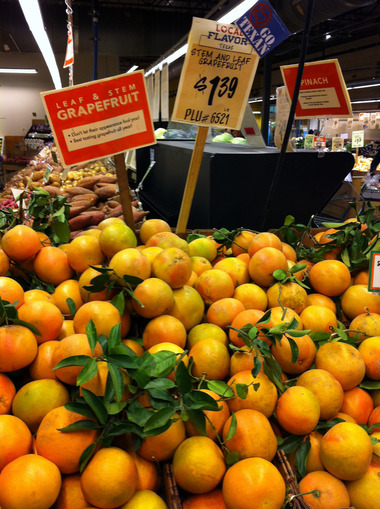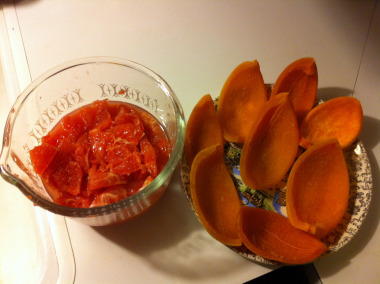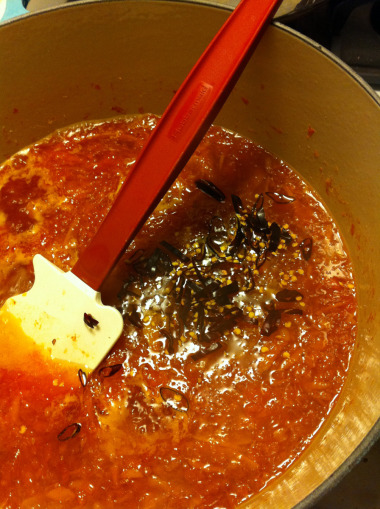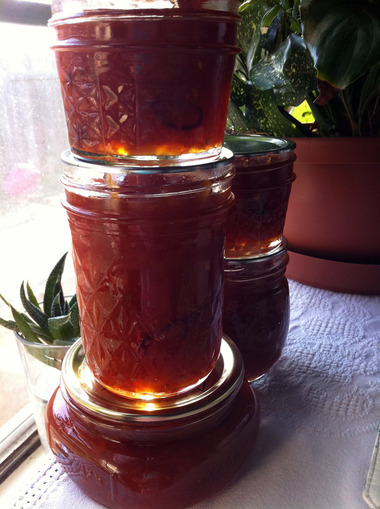I had a great idea this morning as I was mulling over a name for my December entry for the Tigress Can Jam. Naming my creations is always the most fun part for me (aside from eating them, of course). To celebrate the culmination of this year-long canning adventure, I’ve decided to invite you to partake in the naming process.
At the beginning of the Can Jam, I must admit, I didn’t believe I could do a canning project every month. I was so new to canning and it seemed really hard and involved. Something hard and involved thrown into the mix of my already crazy schedule, hmm…Here’s what I actually wrote to the lovely Tigress after she invited me, “Ok, this sounds fun. I’m not sure I can commit to every month because I have a lot on my plate right now, but I can surely try!!”
Try, I did. Succeed, I did. Learn how to make canning not hard and involved, I did. [self pat on back]
I began this adventure with a marmalade, so it only seems fitting to finish with one (not to mention seasonal). This month’s ingredient: anything dried, courtesy of the Tigress herself.
Grapefruit and dried chiles marmalade recipe
modified slightly from Linda Z’s Red Grapefruit Marmalade recipe found in my fave book
yields a little more than 4 half-pints
Marmalade always takes longer than you think. Even with a small batch, you could find yourself all evening at the stove if you don’t break it up.
Prep time: 1 hour 45 min (tops, if you’re excessively speedy or a whiz at de-pithing and de-seeding, then maybe less)
1. I don’t mean to be rude (or make things inconvenient), but I don’t want to re-type/re-word an already excellently written recipe. Buy or borrow Linda’s book (linked above) for fruit prep instructions on page 178. You won’t be sorry. I look in this book almost every day during the height of the preserving season.
Here’s what you’ll end up with after you’ve prepped your two grapefruits. 2. I did things a bit differently than what’s written in the book here. Instead of chopping up the flesh finely and slicing the rinds individually, I pulled out the food processor.
2. I did things a bit differently than what’s written in the book here. Instead of chopping up the flesh finely and slicing the rinds individually, I pulled out the food processor.
I used the shredder tool on all but 3 of the rind quarters, with near success. It clogged a bit and made big rattling noises at the end of each rind batch, but I liked the small slivers that resulted. I slivered the last three by hand for aesthetics, keeping them long and skinny. I pulsed the de-pithed and de-seeded juice and pulp a few times with the regular blade (don’t liquefy it, people).
3. Combine rind slivers and pulp/juice and 4 cups water and bring to a boil. Reduce heat and simmer uncovered for 45 minutes.
Take a break here. Cook dinner, do some dishes. You could even put the mixture in a glass bowl and place it in the fridge overnight if you wish. I wouldn’t do metal since the grapefruit is super acidic (and will leach a metallic flavor into your marmalade).
Cook time: 30 min + 30 min buffer on both ends (waiting for boil and putting in jars)
4. Measure the volume of your grapefruit mixture. Add equal part (or up to 1 cup less) sugar for whatever you come up with.
[I ended up with 4.5 cups of mixture, and had I been using a regular granulated sugar, I would’ve added 3.5 cups sugar , but I used the cane sugar I got on my way driving through Louisiana. I used the full 4.5 cups because this sugar is more like a demerrera sugar, more liquid content (which takes longer to gel your mixture). I didn’t want to chance being up all night waiting for the dang thing to gel.]
Add 3 Tbs strained lemon juice (about what you’ll get from a small lemon) and 1/2 tsp ground cinnamon. Here is where you add the chiles, too. I slivered two large, dried chiles (seeds and all) from a Goya Chile Pulla bag.
5. Heat mixture over medium heat until sugar dissolves and then raise heat to med-high until all areas in the preserving pan reach 220 degrees F. Mine took about 30 min to come to temp. Stir occasionally to make sure sugar isn’t scorching bottom of pan.
6. Remove pan from heat and let sit for 10 min. For an interesting kick add 1/2 tsp pure vanilla extract now. (I went half and half, putting half the marmalade in jars without the vanilla and then I added 1/4 tsp vanilla extract and put the remaining mixture in jars.)
7. Ladle hot marmalade into hot jars (so they don’t break). Wipe rims and seal with two-piece lids.
Processing time: 10 min
Your marmalade will be bitter and smoky with a hint of spice, which is not everyone’s bag. If it ends up being too bitter for your liking, use it as a marinade for the season’s holiday meat dishes. Your ham or lamb or tofurky will love you for it.
How to enter the giveaway…
Submit your idea(s) for this marmalade’s name in the comments section below by midnight EST on Wednesday, December 15. I’ll choose one (not randomly) and notify the winner by email (so don’t forget to enter your email in the appropriate box). I’ll mail the winner a small jar of marmalade in thanks. I can only afford to mail a jar to the US & Canada right now, so readers in other countries, please accept my apologies.
While I’m a sucker for literary-references, all kinds of names are fun and funny; cultural references of all sorts welcome: music, TV, film, life-in-general. See examples of previous jars’ names by rooting around in the Tigress Can Jam tag.
After much deliberation (boy, it was hard to choose!), I’m pleased to announce our winning marmalade namer, Carly from Walla Walla, WA. She submitted, “Maude Ellen Marmalade—Bitter, Smokey with just a bit of Spice—I had a Great Aunt Maude Ellen who was exactly that!” Thanks all for entering!

